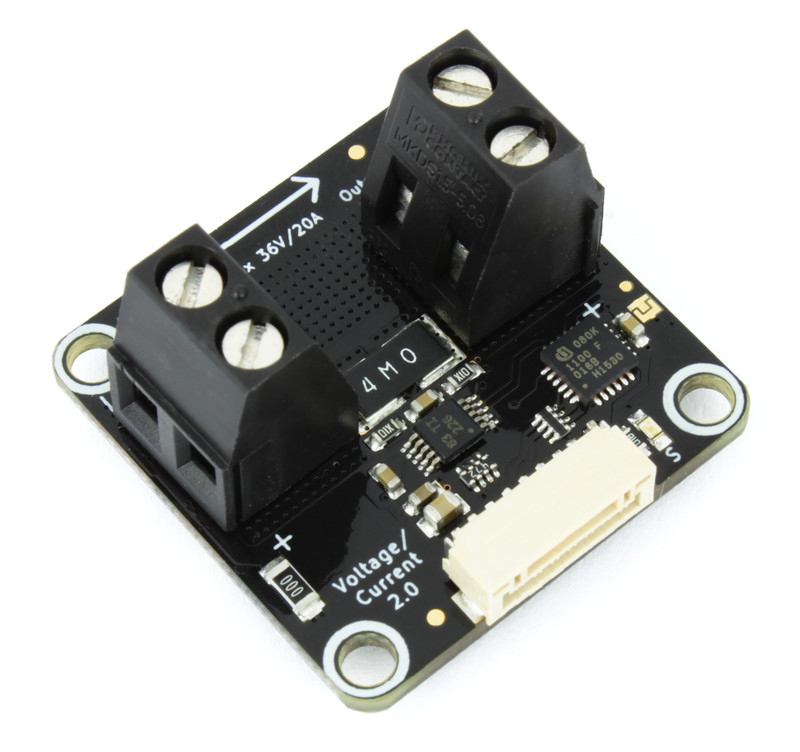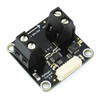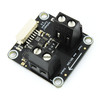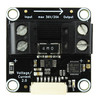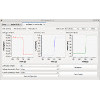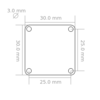- Getting Started
- Hardware
- Bricks
- Bricklets
- Accelerometer Bricklet 2.0
- Air Quality Bricklet
- Ambient Light Bricklet 3.0
- Analog In Bricklet 3.0
- Analog Out Bricklet 2.0
- Analog Out Bricklet 3.0
- Barometer Bricklet
- Barometer Bricklet 2.0
- Breakout Bricklet
- CAN Bricklet
- CAN Bricklet 2.0
- CO2 Bricklet 2.0
- Color Bricklet
- Color Bricklet 2.0
- Compass Bricklet
- DC Bricklet 2.0
- Distance IR Bricklet
- Distance IR Bricklet 2.0
- Distance US Bricklet 2.0
- DMX Bricklet
- Dual Button Bricklet 2.0
- Dust Detector Bricklet
- E-Paper 296x128 Bricklet
- Energy Monitor Bricklet
- GPS Bricklet 2.0
- GPS Bricklet 3.0
- Hall Effect Bricklet
- Hall Effect Bricklet 2.0
- Humidity Bricklet 2.0
- IMU Bricklet 3.0
- Industrial Analog Out Bricklet 2.0
- Industrial Counter Bricklet
- Industrial Digital In 4 Bricklet 2.0
- Industrial Digital Out 4 Bricklet
- Industrial Digital Out 4 Bricklet 2.0
- Industrial Dual 0-20mA Bricklet
- Industrial Dual 0-20mA Bricklet 2.0
- Industrial Dual AC Relay Bricklet
- Industrial Dual Analog In Bricklet 2.0
- Industrial Dual Relay Bricklet
- Industrial PTC Bricklet
- Industrial Quad Relay Bricklet 2.0
- IO-16 Bricklet
- IO-16 Bricklet 2.0
- IO-4 Bricklet 2.0
- Isolator Bricklet
- Joystick Bricklet
- Joystick Bricklet 2.0
- Laser Range Finder Bricklet 2.0
- LCD 128x64 Bricklet
- LCD 20x4 Bricklet
- LED Strip Bricklet 2.0
- Line Bricklet
- Linear Poti Bricklet
- Linear Poti Bricklet 2.0
- Load Cell Bricklet 2.0
- Motion Detector Bricklet 2.0
- Motorized Linear Poti Bricklet
- Multi Touch Bricklet
- Multi Touch Bricklet 2.0
- NFC Bricklet
- OLED 128x64 Bricklet 2.0
- OLED 64x48 Bricklet
- One Wire Bricklet
- Outdoor Weather Bricklet
- Particulate Matter Bricklet
- Performance DC Bricklet
- Piezo Speaker Bricklet
- Piezo Speaker Bricklet 2.0
- Real-Time Clock Bricklet
- Real-Time Clock Bricklet 2.0
- Remote Switch Bricklet 2.0
- RGB LED Bricklet 2.0
- RGB LED Button Bricklet
- Rotary Encoder Bricklet 2.0
- Rotary Poti Bricklet
- Rotary Poti Bricklet 2.0
- RS232 Bricklet
- RS232 Bricklet 2.0
- RS485 Bricklet
- Segment Display 4x7 Bricklet
- Segment Display 4x7 Bricklet 2.0
- Servo Bricklet 2.0
- Silent Stepper Bricklet 2.0
- Solid State Relay Bricklet 2.0
- Sound Intensity Bricklet
- Sound Pressure Level Bricklet
- Temperature Bricklet
- Temperature Bricklet 2.0
- Temperature IR Bricklet 2.0
- Thermal Imaging Bricklet
- Thermocouple Bricklet 2.0
- Tilt Bricklet
- UV Light Bricklet 2.0
- Voltage/Current Bricklet 2.0
- XMC1400 Breakout Bricklet
- Master Extensions
- Power Supplies
- Discontinued Products
- Timeline
- Software
- Kits
- Embedded Boards
- Specifications
Voltage/Current Bricklet 2.0¶
Features¶
- Measure power, voltage and current up to 720W/36V/20A
- 1mW, 1mV, 1mA resolution over the whole range
- Bidirectional current measurement (e.g. charge/discharge)
- Configurable averaging and ADC conversion time
Description¶
The Voltage/Current Bricklet 2.0 can be used to extend Bricks by the possibility to measure power/voltage/current. To do this you only have to put the Bricklet between your power supply (e.g. battery) and your load (e.g. motor).
In case of battery powered systems you can measure the state of the battery by bidirectional current measurement (charge/discharge).
This Bricklet ist not galvanically isolated to the Tinkerforge system. This means that there is a direct electrical connection between the terminals of the Bricklet and the rest of the system. Dependent of the application this can lead to undesired connections, ground loops or short circuits. These problems can be prevented by using the Bricklet together with a Isolator Bricklet.
Technical Specifications¶
| Property | Value |
|---|---|
| Sensor | INA226 with 4mΩ Shunt Resistor |
| Current Consumption | 30mW (6mA at 5V) |
| Maximum Current | ±20A |
| Maximum Input Voltage | 36V |
| Dimensions (W x D x H) | 30 x 30 x 18mm (1.18 x 1.18 x 0.67") |
| Weight | 10g |
Resources¶
Connectivity¶
You have to connect the Voltage/Current Bricklet 2.0 between your power supply and your load. Connect the power supply with the terminal marked with "IN" and the load with the terminal marked "OUT". The polarity is marked with "+" and "-".
Warning
Keep the polarity in mind! This Bricklet is not protected against polarity reversal!
The Bricklet measures the voltage between "+" and "-" of the "IN" terminal as well as the current flow from "+" of the "IN" terminal to "+" of the "OUT" terminal.
Test your Voltage/Current Bricklet 2.0¶
To test a Voltage/Current Bricklet 2.0 you need to have Brick Daemon and Brick Viewer installed. Brick Daemon acts as a proxy between the USB interface of the Bricks and the API bindings. Brick Viewer connects to Brick Daemon. It helps to figure out basic information about the connected Bricks and Bricklets and allows to test them.
Connect the Voltage/Current Bricklet 2.0 to a Brick with a Bricklet Cable. Connect a motor and a battery to the Bricklet as displayed in the following picture.
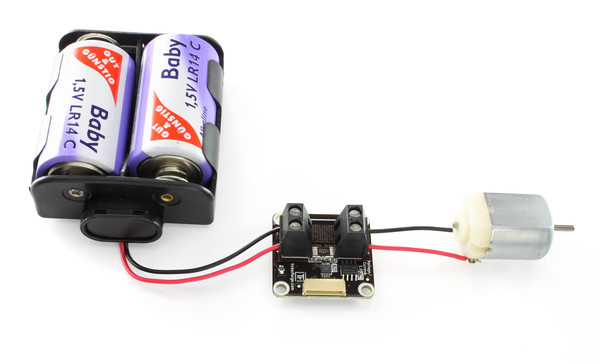
If you connect the Brick to the PC over USB, you should see a new tab named "Voltage/Current Bricklet 2.0" in the Brick Viewer after a moment. Select this tab.
If everything went as expected you can now see the current used by the motor and a graph that shows the current over time.
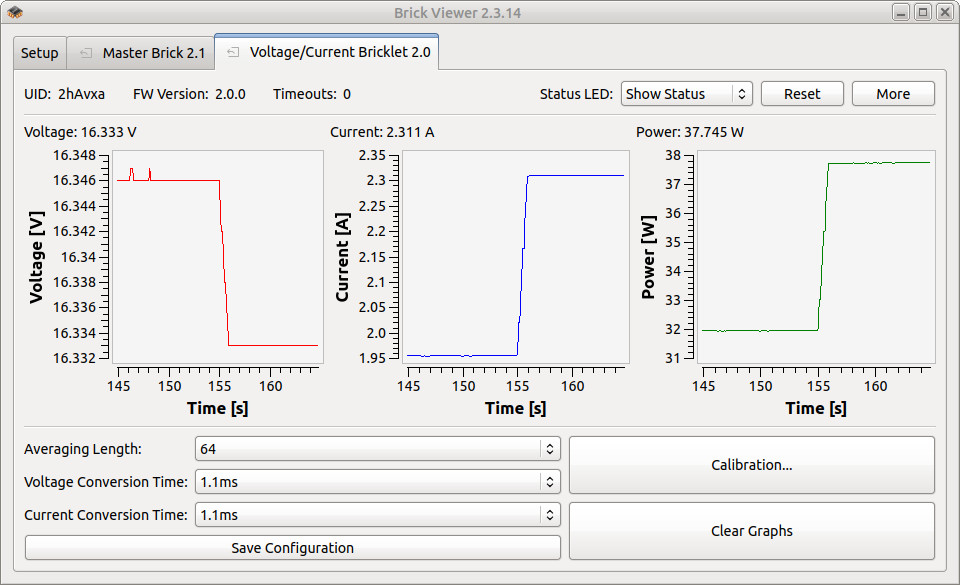
After this test you can go on with writing your own application. See the Programming Interface section for the API of the Voltage/Current Bricklet 2.0 and examples in different programming languages.
Calibration¶
The current measurement of the Voltage/Current Bricklet is factory calibrated at room temperature. The readings can shift by a few mA if the environment is very cold or very hot. In this case you can recalibrate the Bricklet with a precise multimeter:
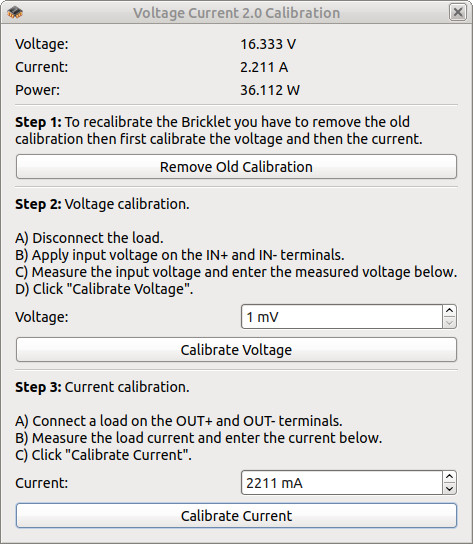
Start Brick Viewer and click on "Calibration..." and follow the steps that are described in the GUI.
You can calibrate the voltage as well as the current measurement. In our experience you don't need to calibrate the voltage, it is within 0.5% accuracy without any calibration.
If you remove the factory current calibration a recalibration is necessary because of tolerances in the shunt resistor.
Case¶
A laser-cut case for the Voltage/Current Bricklet 2.0 is available.
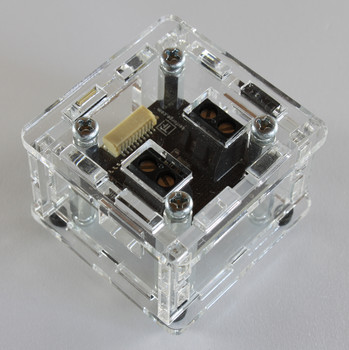
The assembly is easiest if you follow the following steps:
- Screw spacers to the Bricklet,
- screw bottom plate to bottom spacers,
- build up side plates,
- plug side plates into bottom plate and
- screw top plate to top spacers.
Below you can see an exploded assembly drawing of the Voltage/Current Bricklet 2.0 case:
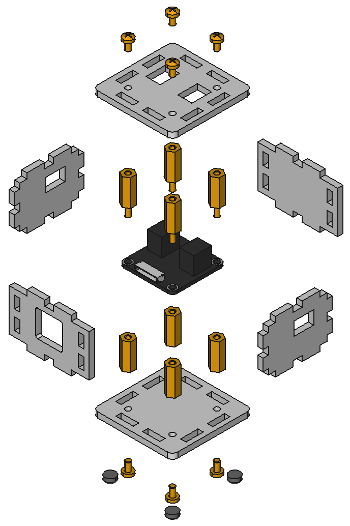
Hint: There is a protective film on both sides of the plates, you have to remove it before assembly.
Programming Interface¶
See Programming Interface for a detailed description.
| Language | API | Examples | Installation |
|---|---|---|---|
| C/C++ | API | Examples | Installation |
| C/C++ for Microcontrollers | API | Examples | Installation |
| C# | API | Examples | Installation |
| Delphi/Lazarus | API | Examples | Installation |
| Go | API | Examples | Installation |
| Java | API | Examples | Installation |
| JavaScript | API | Examples | Installation |
| LabVIEW | API | Examples | Installation |
| Mathematica | API | Examples | Installation |
| MATLAB/Octave | API | Examples | Installation |
| MQTT | API | Examples | Installation |
| openHAB | API | Examples | Installation |
| Perl | API | Examples | Installation |
| PHP | API | Examples | Installation |
| Python | API | Examples | Installation |
| Ruby | API | Examples | Installation |
| Rust | API | Examples | Installation |
| Shell | API | Examples | Installation |
| Visual Basic .NET | API | Examples | Installation |
| TCP/IP | API | ||
| Modbus | API |


